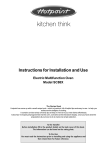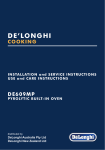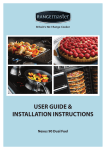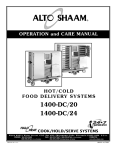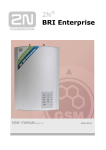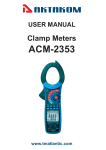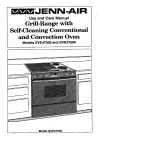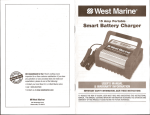Download Fisher & Paykel OB60 User's Manual
Transcript
Installation instructions and User guide Built-in oven OB60 electronic and pyrolytic models NZ AU GB IE Contents Safety and warnings Installation instructions ELECTRONIC MODELS Using your oven for the first time Using the control buttons Selecting the cooking functions Selecting the temperature Cooking functions Manual and automatic cooking Error codes Care and cleaning PYROLYTIC MODELS Using your oven for the first time Clock and timer Selecting the functions and temperature Cooking functions Automatic cooking Care and cleaning Warranty and service Important! SAVE THESE INSTRUCTIONS The models shown in this User Guide may not be available in all markets and are subject to change at any time. For current details about model and specification availability in your country, please go to our website www.fisherpaykel.com or contact your local Fisher & Paykel dealer. 1 2 5 11 12 14 15 16 18 19 20 30 31 32 33 35 36 42 2 Safety and warnings Installation WARNING! Electrical Shock Hazard Always disconnect the oven from the mains electricity supply before carrying out any maintenance operations or repairs. Failure to do so may result in death or electrical shock. WARNING! Cut Hazard Take care - panel edges are sharp. Failure to use caution could result in injury or cuts. Important safety precautions To avoid hazard, follow these instructions carefully before installing or using this product. Please make this information available to the person installing the product as it could reduce your installation costs. This oven is to be installed and connected to the electricity supply only by an authorised person. If the installation requires alterations to the domestic electrical system call a qualified electrician. He should also check that the socket cable section is suitable for the electricity drawn by the oven. The oven must be earthed. To connect the oven to the mains, do not use adapters, reducers or branching devices as they can cause overheating and burning. Installation must comply with your local building and electricity regulations. Failure to install the oven correctly could invalidate any warranty or liability claims. Before you install the oven, please make sure that A suitable disconnection switch is incorporated in the permanent wiring, mounted and positioned to comply with the local wiring rules and regulations. The switch must be of an approved type installed in the fixed wiring and provide a 3 mm air gap contact separation in all poles in accordance with the local wiring rules. In Australia and New Zealand, a switch of the approved type with a 3 mm air gap must be installed in the active (phase) conductor of the fixed wiring. The location of the oven connection socket (if fitted) is outside the cavity if the product is flush to the rear wall. The electrician allows at least 1.5 m (and not more than 2 m) free length of connection cable within the cavity for ease of installation and servicing of the product. The mains cable should not touch any hot metal parts. Safety and warnings 3 The oven will rest on a surface that can support its weight. The benchtop and oven cavity are square and level, and are the required dimensions. The height from the floor suits the user. The oven door can open fully without obstruction. If the supply cord is damaged, it is replaced by the manufacturer, its service agent, or a similarly qualified person in order to avoid a hazard. When you install the oven Do not seal the oven into the cabinetry with silicone or glue. This makes future servicing difficult. Fisher & Paykel will not cover the costs of removing the oven, or of damage caused by this removal. Use the supplied screws to secure the oven to the cabinetry. Do not over-tighten the screws. (See Fig. 1) Do not stand on the door, or place heavy objects on it. Do not lift the oven by the door handle. 2.5 mm Figure 1 Securing the oven to the cabinetry 4 Safety and warnings Operation Your built-in oven has been carefully designed to operate safely during normal cooking procedures. Please keep the following guidelines in mind when you are using your oven: WARNING! Electrical Shock Hazard Switch the oven off at the wall before replacing fuses or the oven lamp. Failure to do so may result in death or electrical shock. WARNING! Hot Surface Hazard Accessible parts will become hot when this oven is in use. To avoid burns and scalds keep children away. Do not touch hot surfaces inside the oven. Use oven mitts or other protection when handling hot surfaces such as oven shelves or dishes. Take care when opening the oven door. Let hot air or steam escape before removing or replacing food. Failure to do so could result in burns and scalds. Important safety precautions Isolating switch: make sure this oven is connected to a circuit which incorporates an isolating switch providing full disconnection from the power supply. Household appliances are not intended to be played with by children. Children, or persons with a disability which limits their ability to use the appliance, should have a responsible person to instruct them in its use. The instructor should be satisfied that they can use the appliance without danger to themselves or their surroundings. Safe food handling: leave food in the oven for as short a time as possible before and after cooking. This is to avoid contamination by organisms which may cause food poisoning. Take particular care during warmer weather. Do not place aluminium foil, dishes, trays, water or ice on the oven floor during cooking as this will irreversibly damage the enamel. Do not stand on the door, or place heavy objects on it. Do not use harsh abrasive cleaners or sharp metal scrapers to clean the oven door glass since they scratch the surface, which may result in shattering of the glass. Do not use a steam cleaner to clean any part of the oven. Caution. Hot air can blow from under the control panel as part of the oven's cooling system. Installation instructions I I C E I K B 5 J J I L D A 16-20 mm H F L G 2.5 mm Installation diagrams for illustration purposes only Figure 2 Product and cabinetry dimensions Product and cabinetry dimensions (mm) A overall height* of product B overall width of product C overall depth of product (excluding handle and knobs) D height of chassis E width of chassis F depth of chassis G depth of oven frame and control panel (excl. knobs) H depth of oven door (open) (measured from front of oven frame) I minimum inside width of cavity overall width of cavity II J inside height of cavity overall height of cavity JI K minimum inside depth of cavity L flush fitting cabinetry clearance Note: If installing a cooktop above the oven ensure adequate clearance is provided for the cooktop as per the cooktop manufacturer’s instructions. *All height measurements include mounted feet. 597 595 567 582 556 545 22 445 560 600 585 600 550 22 6 Air circulation OVEN DOOR LOWER TRIM AIR FLOW Important: Figure 3 Correct and incorrect placement of trim Please take extra care not to damage the lower trim of the oven. The space between the bottom of the door and the lower trim is important for the correct air circulation into the oven. Ensure the oven sits on wooden blocks or similar supports when it is removed from the carton as shown in Fig. 3. This will prevent any damage to the lower trim. After installation check the lower trim is still undamaged. Open the oven door slowly to its fully open position ensuring there is adequate clearance between the bottom of the door and the lower trim. Should the lower trim become damaged, straighten the trim and ensure the oven door opens fully without obstruction from the lower trim. Note: You can remove the feet but ensure that the oven does not sit on the lower trim. The manufacturer does not accept responsibility for any damage to the oven resulting from incorrect installation. Replacing the power supply cable 7 Unhook the terminal board cover by inserting a screwdriver into the two hooks “A” (fig. 5). Open the cable crimp by unscrewing screw “F” (Fig. 6), unscrew the terminal screws and remove the cable. Connect the new supply cable, of suitable type and section, to the terminal board following the diagram in Fig. 4. Electronic 230-240 V~ 3600-3830W Pyrolytic 230-240 V~ 3095-3370W L1 N (L2 ) E Figure 4 F A Figure 5 Feeder cable section type HO5RR-F 230- 240 V 3 x 1.5 mm2 Figure 6 8 Wiring diagram Electronic models T Filter T TL L TL N M LF1 LF2 VR VT TE GE BE CE Figure 7 Electronic oven wiring diagram Wiring diagram Pyrolytic oven NZ AU models Figure 8a Pyrolytic oven wiring diagram Pyrolytic oven GB IE models Figure 8b Pyrolytic oven wiring diagram 9 10 11 Clock display Temperature display Functions display Cooking functions buttons Temperature buttons Control buttons Figure 9 Control panel 1 2 3 4 5 Before using your new oven, please: Read this user guide, taking special note of the ‘Safety and warnings’ section. Remove all accessories and packaging. Set the clock. The oven will not work until the clock has been set. Condition the oven: Put in the shelves and trays. If you are not using the sliding shelf supports, then slide in the shelves and grill pan as shown in Fig 10. Fit them between the metal runners, with the safety stop notch down and at the back. If the shelf supports and catalytic panels are not already fitted, see ‘Care and cleaning’ for how to do this. Heat the oven on maximum for: 60 minutes in the position 30 minutes in the position position 15 minutes in the Wipe out the oven with a damp cloth and mild detergent, and dry thoroughly. Figure 10 Correct position of shelves and pan Note: the oven cooling fan comes on automatically at different stages of the cooking cycle. It blows out warm air above the door. When the oven is turned off, the cooling fan may stay on until the oven cools down. ELECTRONIC MODELS Using your oven for the first time ELECTRONIC MODELS 12 Using the control buttons SYMBOL Lit = minute minder in operation Flashing = countdown completed by the minute minder DIGITS Normally time of the day SYMBOL SYMBOL Lit = operation of heating elements (cooking functions) Flashing = automatic cooking completed Lit = automatic cooking programmed Flashing = automatic cooking completed BUTTON BUTTON ON/OFF or Childlock selection To increase the numbers on the programmer display BUTTON Minute minder selection BUTTON To decrease the numbers on the programmer display BUTTON Cooking time selection BUTTON End cooking time selection Figure 11 Clock display and control buttons Note: After using the control buttons, wait for three beeps to confirm that you can proceed. To select the volume of the beeps, press the button. 13 Setting the clock When first connected, or after a power failure, ‘0:00’ will show on the display. To set the clock, press the and buttons together and then press the Note: Changing the time will delete any automatic program. and buttons. Using the timer You can use the timer at any time, even when the oven is not in use. The timer does not turn the oven off. The timer can be set for up to 23 hours and 59 minutes. To set the timer, press the button, then the and buttons. To check the remaining time press the button. When the time is up, the timer will beep. Press any button (except the button) to turn it off. Turning the oven on and off To turn the oven on, press the button. ‘On’ appears for two seconds on the display, the oven lamp lights up, and then the time appears on the display. You can now operate your oven. If you do not use your oven within three minutes, it automatically goes back to stand-by. ‘OFF’ appears for some seconds on the display, the oven lamp goes off, and then the time appears on the display. To turn the oven off, press the button. Note: do not turn the oven off if you have set it for automatic cooking. Childlock In Childlock you can only turn the oven off, use the timer, and check the remaining cooking time or the end of the cooking time. You can set Childlock during cooking. button for about five seconds. The display shows ‘n--O’, ‘On’ and To set the Childlock, press the then the time appears again. button for about five seconds. The display shows ‘n--O’, To release the Childlock, press the ‘OFF’ and then the time appears again. ELECTRONIC MODELS Using the control buttons Selecting the cooking functions ELECTRONIC MODELS 14 Oven cookingfunctions functions Oven cooking When you select each cooking function, its When you select each symbol cookingis function, activated. its symbol is activated. setting Oven Ovenlamp lamp When the symbol is lit only the oven lamp isWhen on. the symbol is lit only the oven lamp is on. setting Function Functionbuttons control buttons You buttons to choose the the ovenoven Youcan canuse usethese these buttons to choose function functionyou youwant. want. Figure 12 Cooking functions 15 ELECTRONIC MODELS Selecting the temperature “" o "“ (Celsius (Celsius degrees) symbol degrees) symbol When flashing thethe oven is preheating. Whenthe thesymbol symbolis is flashing oven is preheating. When the symbol is permanently lit the oven is at the set temperature. When the symbol is permanently lit the oven is at the set temperature. Cooking Cookingtemperature temperature All start to to operate withwith a pre-set Allcooking cookingfunctions functions start operate a pre-set temperature. You can modify this at any time by pressing temperature which can be modified, at any time, the temperature control buttons. pressing the temperature control buttons. Temperature buttons Temperature control buttons Press button increasethe theoven oventemperature. temperature. Press thethe button to to increase Press the button to decrease the oven temperature. Press the button to decrease the oven temperature. Figure 13 Temperature selection ELECTRONIC MODELS 16 Cooking functions OVEN LAMP Only the oven light comes on. It remains on in all the cooking functions. BAKE The upper and lower heating elements come on. BAKE is the traditional method of cooking. It is best to cook on only one shelf at a time in this function. PASTRY ASSIST The lower heating element and the fan come on. Use this function to cook food that requires a higher temperature at the bottom than the top. GRILL The grill at the top of the oven comes on. Preheat for two minutes. Use with the oven door closed and the temperature knob between 50 °C and 225 °C max. Do not grill for longer than 30 minutes at any one time. TURBO GRILL Both the grill and the upper heating element come on, for intense grilling over the whole width of the oven. Preheat for two minutes. Use with the oven door closed and the temperature knob between 50 °C and 225 °C max. FAN GRILL Both the grill and the fan come on. Use with the oven door closed and the temperature knob between 50 °C and 225 °C max. FAN FORCED WITH LOWER HEAT The lower heating element, the circular heating element, and the fan come on. FAN FORCED The circular heating element and the fan come on. The oven set on FAN FORCED can cook several different foods together. Use FAN FORCED for multi-shelf cooking. 17 FAN BAKE The upper and lower heating elements and the fan come on. DEFROST/WARM The lower heating element and the fan come on. To defrost food, use at the preset temperature only (‘dEF’). To warm food, change the preset temperature to between 75 OC and 100 OC. Note: this function is not for cooking food. Important! Safe food handling: leave food in the oven for as short a time as possible before and after cooking or defrosting. This is to avoid contamination by organisms which may cause food poisoning. Take particular care during warmer weather. Notes on baking and roasting: Only use the fat filter for roasting. Remove before baking. Always clean the filter after cooking. Preheat the oven before baking. Do not place anything, including water or ice, on the oven floor. ELECTRONIC MODELS Cooking functions ELECTRONIC MODELS 18 Manual and automatic cooking Using the oven manually To use the oven manually, turn it on, and then select the function and temperature. The oven will start to operate about four seconds after your last selection. If ‘A’ is shown on the display, then you need to cancel the pre-set automatic cooking. To do this, press the and buttons together. Note: you can only use the oven manually for up to 10 hours. After that, it switches off automatically. Using the oven automatically Use automatic cooking to automatically turn the oven on, cook, and then turn the oven off. 1 2 3 4 5 Check the clock shows the correct time. Select the function and temperature. The oven will come on. Decide how long the food will take to cook, allowing time for preheating if necessary. Press the button. 0.00 will show. Using the buttons, set the cooking time. Select the time you would like the oven to turn off by pressing the button, and then using the buttons. If there is time to wait before cooking starts, the current time of day and A will show in the clock display. The oven temperature and function lights will remain on, but the oven will switch off and is now set for automatic cooking. Note: the cooling fan may remain on. If you are already at home to turn the oven on and only want the oven to turn off automatically, start cooking as normal, then follow step 4 or step 5 to set a time to stop the oven. When automatic cooking starts, A will be displayed and the oven will turn on. To see the remaining cook time, press the button. To see the set stop time, press the button. To cancel automatic cooking at any time, turn the oven off or to continue cooking, press the and buttons together. When the stop time is reached, the oven will turn off, the timer will beep and A will flash. Press any button to stop the beeping and return the oven to manual mode. button to turn the oven off. Press the Important! Safe food handling: leave food in the oven for as short a time as possible before and after cooking. This is to avoid contamination by organisms which may cause food poisoning. Take particular care during warmer weather. 19 Error codes If there is a problem the oven is automatically switched off. Only the cooling fan motor operates and an error message appears on the display. The oven cannot be used. If the problem disappears the oven returns to the stand-by (OFF) condition. If the problem does not disappear turn the oven off and on again from the mains. If the problem continues, disconnect the oven from the mains and contact your Authorised Service Centre. Important! “---- ” Message on both clock and temperature displays This indicates that the oven has overheated. You cannot use the oven until you have reactivated the oven. To do this: Open the oven door and let it cool. Press and buttons together. ‘0.00’ will flash on the display. Reset the clock. If the oven still does not work, disconnect the oven from the mains and contact the Authorised Service Centre. Figure 14 Error codes on the temperature display Figure 15 Error codes on the clock display ELECTRONIC MODELS Error codes ELECTRONIC MODELS 20 Care and cleaning Important! Before you start cleaning your oven, please: Read these cleaning instructions and the ‘Safety and warnings’ section at the start of this user guide. Turn the oven off at the wall. Make sure the oven is a safe temperature to touch. Do not use a steam cleaner. Do not keep flammable substances in the oven. General advice Wipe out the oven after every use. Wipe up spills. Avoid leaving alkaline or acidic substances (such as lemon juice or vinegar) on the oven surfaces. Do not use cleaning products with a chlorine or acidic base. Cleaning the outside of the oven Important! Do not use abrasive cleaners, cloths or pads on the outside surfaces of the oven. Immediately wipe off any caustic cleaners if they are spilled onto the oven door handle. Wipe the oven’s outside surfaces often, using warm water and a mild household detergent. The stainless steel may also be cleaned with a suitable cleaner and polish. Note: if you choose to use a commercial stainless steel cleaner, please read the label to make sure it does not contain chlorine compounds as these are corrosive and may damage the appearance of your oven. 21 Cleaning the inside of your oven Do not use abrasive cleaners, cloths or pads to clean the enamel. Do not use any oven cleaners, abrasive cleaners, ammonia-based cleaners, products containing acids or alkalis, or detergents on the catalytic panels (not supplied with all models). Fig.16 Removing the side racks and catalytic panels (some models only) Fig.17 Drop-down grill element (some models only) To make cleaning easier, you can remove the side racks, the oven door, and the grease filter. Once you have removed the side racks, the top grill element also drops down to make cleaning easier (some models only). The grill element is self-cleaning. Cleaning the enamel cavity Clean the enamel on the inside of the oven when it has cooled down, using household detergents or an ammonia-based cleaner. You may use ‘off the shelf’ oven cleaners, if you carefully follow the manufacturers’ instructions. Caring for the catalytic panels (some models only) The catalytic panels are covered with a special microporous enamel which absorbs and does away with oil and fat splashes during normal cooking over 200 °C. If, after cooking very fatty foods, the panels remain dirty, heat the oven on maximum for an hour to an hour and a half, and they will self-clean. The side panels are reversible. Make sure that you replace them with the arrow up, and on the correct side. To remove the side catalytic panels you first need to unscrew the side racks. See Fig. 16. When you replace the panels, make sure that: The arrows are pointing upwards The panel with the hole in it is on the left oven wall, so that there is a hole for the oven lamp. Do not put the catalytic panel without the hole over the oven lamp. Then screw the side racks back onto the oven wall. Note: the back panel of the oven is also a catalytic liner, but this is not reversible and should not be removed. ELECTRONIC MODELS Care and cleaning ELECTRONIC MODELS 22 Care and cleaning Cleaning the fat filter Clean the fat filter after every use. If the filter is not cleaned, it will block and shorten the life of the fan element. For normal soiling, place the filter in a dishwasher on normal wash. If the filter is very dirty, place in a saucepan with either two tablespoons of clothes washing powder, or one tablespoon of dishwashing powder. Bring to the boil and leave to soak for at least 30 minutes. Rinse the filter in clean water and dry. Fig.18 Removing the fat filter 23 Sliding shelf supports (some models only) The telescopic sliding shelf supports make it safer and easier to insert and remove the oven shelves and trays. They stop when they are pulled out to the maximum position. Wipe the supports with a damp cloth and a mild detergent only. Do not wash them in the dishwasher, immerse them in soapy water, or use oven cleaner on them. 1 2 3 4 1 2 To remove the sliding shelf supports: Remove the side racks by unscrewing the fixing screws (Fig. 16) Lay down the sliding shelf support and side racks, with the sliding shelf support underneath. Find the safety locks. These are the tabs that clip over the wire of the side rack (arrow 1 in Fig. 19). Pull the safety locks away from the wire to release the wire (arrow 2 in Fig. 19) To re-fix the sliding shelf support onto the side racks: Screw the side rack onto the oven wall Fit the sliding shelf support onto the top wire of a rack and press (Fig. 20). You will hear a click as the safety locks clip over the wire. Important! When fitting the sliding shelf supports, make sure that you fit: The slides to the top wire of a rack. They do not fit on the lower wire. The slides so that they run out towards the oven door, as shown in Fig. 20 Both sides of each pair of shelf slides Both sides on the same level. Note: you cannot fit the sliding shelf supports to the top shelf position 1 2 1 Fig.19 Removing the sliding shelf supports Fig.20 Refitting the sliding shelf supports ELECTRONIC MODELS Care and cleaning 24 Care and cleaning ELECTRONIC MODELS Cleaning the oven door glass Do not use harsh abrasive cleaners or sharp metal scrapers to clean the oven door glass since they scratch the surface, which may result in shattering of the glass. The oven door has three panes of glass. To clean these, you need to remove the inner and middle panes. Fig.21a Removing the inner and middle panes of glass A 1 2 Lock the door open: Fully open the oven door (Fig. 21a). Fully open the lever “A” on the left and right hinges. (Fig 21b) Gently close the door (Fig. 21c) until the left and right hinges are hooked to part “B” of the door (Fig. 21b) Remove the inner pane: Remove the seal “G” by unhooking the three fixing hooks (Fig. 21d). Gently pull out the inner pane of glass (Fig. 21e) Clean the glass with an appropriate cleaner. Dry thoroughly, and place on a soft surface. B Fig.21b Fig.27 Fig.21c G Fig.21e Fig.21d Care and cleaning Remove the middle pane: Gently unlock the middle pane of glass from the bottom clamps by moving it as in Fig. 22b. Gently lift the bottom edge of the pane (arrow 1 in Fig. 22c) and remove it by pulling it out from the top clamps (arrow 2 in Fig. 22c). Clean the glass with an appropriate cleaner. Dry thoroughly, and place on a soft surface. ELECTRONIC MODELS 3 25 Fig.22a Now you can also clean the inside of the outer glass. Fig.22b 1 2 Fig.22c ELECTRONIC MODELS 26 Care and cleaning Replacing the middle and inner panes of glass 1 2 Make sure the door is locked open (see Figs 21a - 21c) Replace the middle pane: Check that the four rubber pads are in place (“M” in Fig. 23a) Check that you are holding the pane the correct way. You should be able to read the wording on it as it faces you. Gently insert the top edge of the pane into the top clamps (arrow 1 in Fig. 23b), then lower the pane and insert the bottom edge into the bottom clamps (arrow 2 in Fig. 23b); and then slide the pane into position (Fig. 23c) M Fig.23a 1 2 1 Fig.23b Fig.23c 3 4 Replace the inner pane: Check that the four rubber pads are in place (“D” in Fig. 24a) Check that you are holding the pane the correct way. You should be able to read the wording on it as it faces you. Insert the pane in the left “E” and right “F” slide guides, and gently slide it to the retainers “H” (Fig. 24c) Replace the seal “G” by hooking in the three fixing hooks. Make sure that you put it in the correct way. (Fig. 24e) Unlock the oven door by opening it completely and closing the lever “A” on the left and right hinges (Fig. 24d) 27 ELECTRONIC MODELS Care and cleaning D Fig.24a E F Fig.24b H Fig.24c G A Fig.24e Fig.24d ELECTRONIC MODELS 28 Care and cleaning Removing the oven door The oven door can easily be removed as follows: Open the door to the full extent (Fig. 25a). Open the lever “A” completely on the left and right hinges (Fig. 25b). Hold the door (fig. 25c). Gently close the door until left and right hinge levers “A” are hooked to part “B” of the door (fig. 25d) Withdraw the hinge hooks from their location following arrow “C” (Fig. 25e). Rest the door on a soft surface. To replace the door, repeat the above steps in reverse order. Fig.25a A B Fig.25b Fig.25c C Fig.25e Fig.25d 29 Replacing the oven lamp Let the oven cavity and the heating elements cool down. Left lamp: Remove the side rack (and the side catalytic liner if supplied) by unscrewing the fixing screws. Press down from the top the protective cover A (Fig. 26) and remove it by rotating on the lower side. Important! Never use screwdrivers or other utensils to remove the cover A. This could damage the enamel of the oven or the lampholder. Only use your hands. Unscrew and replace the bulb B with a new one suitable for high temperatures (300°C) with the specifications: 230-240V 50 Hz, 25W, E14. Refit the protective cover A operating in reverse order. ATTENTION: the notch in the inner edge of the cover must be oriented toward the lamp. Replace the side rack (and the side catalytic liner if supplied). Top right lamp: Remove the protective cover C (Fig. 26). Unscrew and replace the bulb B with a new one suitable for high temperatures (300°C) with the specifications: 230-240V 50 Hz, 25W, E14 Refit the protective cover. Note: Oven bulb replacement is not covered by your warranty. 1 A 2 B A B C A Fig.26 Removing the oven lamps ELECTRONIC MODELS Care and cleaning PYROLYTIC MODELS 30 Using your oven for the first time Temperature Door locked Function indicator light indicator light indicator light Clock display Control buttons Temperature knob Function knob Figure 27 Control panel 1 2 3 4 Before using your new oven, please: Read this user guide, taking special note of the ‘Safety and warnings’ section. Remove all accessories and packaging. Set the clock. The oven will not work until the clock has been set. Condition the oven: Slide in the shelves and grill pan as shown in Fig. 28, with the safety stop notch up and at the back. Heat the oven on maximum for: 60 minutes in the position 30 minutes in the position 15 minutes in the position Note: the oven cooling fan comes on automatically at different stages of the cooking cycle. It blows out warm air above the door. When the oven is turned off, the cooling fan may stay on until the oven cools down. 5 Wipe out the oven with a damp cloth and mild detergent, and dry thoroughly. Figure 28 Correct position of shelves 31 Heating Heating elements working elements working Programme Programmeset set A oror in in progress progress U T O A U T O Timer working Button 6 6 Button Function figures Function figures forwards forwards Button Button1 1 Timer Timer Button 2 Button 2 Cooking time or Cooking time or pyrolysis time pryolysis time Button 3 Button 3 Finish cooking time time ororconfirmation confirmation to to start pyrolysis cycle. cycle start pyrolysis Button 4 4 Button SetSet oven oven temperature temperature Button 5 5 Button Function figures figures Function backwards backwards Figure 29 Clock display and control buttons Setting the clock When first connected, or after a power failure, ‘12.00’ will flash on the display. To set the clock, press the and buttons together. The ‘.’ symbol will flash on the display. Then press the and buttons until the clock shows the correct time. Note: Changing the time will delete any automatic program. Using the timer You can use the timer at any time, even when the oven is not in use. The timer does not turn the oven off. The timer can be set for up to 23 hours and 59 minutes. To set the timer, press the button then the and buttons. To check the remaining time press the button. When the time is up, the timer will beep. Press any button to turn it off. PYROLYTIC MODELS Clock and timer PYROLYTIC MODELS 32 Selecting the functions and temperature Selecting the functions Select the cooking function by turning the function knob. Always cook and grill with the oven door closed. Note: all cooking functions start to operate with a pre-set temperature. You can modify this at any time. Selecting the temperature You can vary the temperature by: Turning the temperature knob Pressing the control buttons. If °C is not flashing, press the button first. Press the and buttons . Temperature button Note: Figure 30 Function knob Temperature knob Figure 31 Temperature selection The temperature knob is very sensitive and may feel loose to the touch. Do not force it beyond the ‘-’ and ‘+’ symbols. The value shown in the display shows the oven cavity temperature. To turn the oven off, turn the function knob to O. 33 OVEN LAMP Only the oven light comes on. It remains on in all the cooking functions, except for PYROLYTIC SELF-CLEAN. DEFROST The oven lamp and the fan come on. The fan circulates air around the oven speeding up the defrosting process by approximately 30%. Note: this function is not for cooking food. Important! Safe food handling: leave food in the oven for as short a time as possible before and after cooking or defrosting. This is to avoid contamination by organisms which may cause food poisoning. Take particular care during warmer weather. FAN FORCED The circular heating element and the fan come on. The oven set on FAN FORCED can cook several different foods together. Use FAN FORCED for multi-shelf cooking. BAKE The upper and lower heating elements come on. Bake is the traditional method of cooking. It is best to cook on only one shelf at a time in this function. TURBO FAN GRILL The grill, the upper heating element and the fan come on. This function is similiar to using a rotisserie. Use with the oven door closed and the temperature knob between 50 °C and 250 °C max. GRILL The grill at the top of the oven comes on. Preheat for two minutes. Use with the oven door closed and the temperature knob between 50 °C and 250 °C max. Do not grill for longer than 30 minutes at any one time. FAN GRILL Both the grill and the fan come on. Use with the oven door closed and the temperature knob between 50 °C and 250 °C max. PYROLYTIC SELF-CLEAN During a self-clean cycle the oven reaches higher temperatures than it does for cooking and this breaks down soil and grease deposits. PYROLYTIC MODELS Cooking functions PYROLYTIC MODELS 34 Cooking functions Notes on baking: Preheat the oven before baking Do not place anything, including water or ice on the oven floor Cooking troubleshooting 1 do•Lo appears during cooking Oven not working properly. What to do: Turn the function selector to O, Wait for the oven to cool down completely. Disconnect the oven from the mains. Call your Authorised Service Centre. Note: if ‘do•Lo’ appears during the pyrolytic self-clean cycle then you should be able to use your oven again once it has cooled down completely. See the ‘Care and cleaning’ section. 2 Display OFF Oven not working properly. What to do: Turn the function selector to 0 (oven OFF) Wait for the oven to cool down completely. Switch the oven off for a few seconds. If after this procedure the display is still off: Disconnect the oven from the mains. Call your Authorised Service Centre. The oven must not be used. 35 Use automatic cooking to automatically turn the oven on, cook, and then turn the oven off. 1 2 3 4 5 Check the clock shows the correct time. Select the function and temperature. The oven will come on. Decide how long the food will take to cook, allowing time for preheating if necessary. Press the button. 0.00 will show. Using the buttons, set the cooking time. Select the time you would like the oven to turn off by pressing the button, and then using the buttons. If there is time to wait before cooking starts, the current time of day and AUTO will show in the clock display. The oven temperature and function lights will go out and the oven will switch off but is now set for automatic cooking. Note: the cooling fan may remain on. If you are already at home to turn the oven on and only want the oven to turn off automatically, start cooking as normal, then follow step 4 or step 5 to set a time to stop the oven. When automatic cooking starts, AUTO will be displayed and the oven will turn on. To see the remaining cook time, press the button. To see the set stop time, press the button. To cancel automatic cooking at any time, turn the temperature and function knobs to the off O position. When the stop time is reached, the oven will turn off, the timer will beep and AUTO will flash: Turn the temperature and function knobs to the off O position. Important! Safe food handling: leave food in the oven for as short a time as possible before and after cooking. This is to avoid contamination by organisms which may cause food poisoning. Take particular care during warmer weather. PYROLYTIC MODELS Automatic cooking PYROLYTIC MODELS 36 Care and cleaning Important! Before you start cleaning your oven, please: Read these cleaning instructions and the ‘Safety and warnings’ section at the start of this user guide. Make sure the oven is a safe temperature to touch. Do not use a steam cleaner. Do not keep flammable substances in the oven. General advice Wipe out the oven after every use. Wipe up spills. Avoid leaving alkaline or acidic substances (such as lemon juice or vinegar) on the oven surfaces. Do not use cleaning products with a chlorine or acidic base. Cleaning the outside of the oven Important! Do not use abrasive cleaners, cloths or pads on the outside surfaces of the oven. Immediately wipe off any caustic cleaners if they are spilled onto the oven door handle. Wipe the oven’s outside surfaces often, using warm water and a mild household detergent. The stainless steel may also be cleaned with a suitable cleaner and polish. Note: if you choose to use a commercial stainless steel cleaner, please read the label to make sure it does not contain chlorine compounds as these are corrosive and may damage the appearance of your oven. Cleaning the oven door glass Do not use sharp metal scrapers to clean the oven door glass. Clean the exterior glass surface with a mild solution of detergent and warm water. Use a glass cleaner to remove any smears or fingerprints. Dry the glass using a soft lint-free cloth. Note: The interior oven door glass will be cleaned during a self-clean cycle. Care and cleaning Using the pyrolytic self-clean function Important! Do not use oven cleaners, any degreasing cleaners, or oven liners. Do not clean the door or cavity seals, or use any oven cleaning products on the seals. Do not use your oven to clean miscellaneous parts. Make sure the room is well ventilated. Move any caged birds to another closed and well-ventilated room, as some birds are extremely sensitive to oven self-cleaning fumes. If there are cracks or flaws on the oven door glass (inside or outside), if the seals are ruined or worn, or if the door does not close properly, uplug the oven and contact your Authorised Service Centre. Note: use this function only when the oven needs cleaning. Do not wait until it is very dirty. I I I I I I Note: you can adjust the self-clean cycle time between one hour 30 minutes and three hours, depending on how dirty the oven is. To do this, press button 2 and then button 5 or 6. I I I I 5 Remove the oven shelves and all other cookware/utensils. Wipe up large food spills. Failure to do so may discolour the enamel. Close the oven door. Turn the function knob to . PO.OO appears with the letter P flashing. Press button 3. P1.30 (pyrolytic self-clean cycle of one hour 30 minutes) will appear, and the door locked indicator and temperature lights will be lit. I I 1 2 3 4 1 2 3 4 5 6 Figure 32 Self-clean cycle displays The self-clean cycle starts immediately, and the time remaining is displayed. When the oven has finished cleaning, PO.OO will appear with AUTO flashing. PO.OO will remain until the oven temperature drops below 300 oC. Then AUTO and the letter P will flash and the door locked and temperature indicator lights will go out. 6 7 8 Turn the function knob to O. The time will appear. Wait for the oven to cool down completely. Remove the grey ash with a small brush or damp cloth, then wipe out the oven with a clean damp cloth, and dry with a clean lint-free cloth. Important! Wait for the oven to cool down completely before using it again. To stop the self-clean cycle, turn the function knob to O. We do not recommend stopping the cycle, and then starting it again. PYROLYTIC MODELS 37 PYROLYTIC MODELS 38 Care and cleaning Pyrolytic self-clean troubleshooting 1 The self-clean cycle has been cancelled by turning the function knob to O. What to do: Wait for the door to unlock. This happens automatically when the temperature inside the oven drops below 300 OC. Wait for the oven to cool down completely before using it again. 2 The self-clean cycle has been cancelled by turning the function knob to a cooking function. The selected cooking function will start. What to do: Turn the function knob to O Wait for the door to unlock. This happens automatically when the temperature inside the oven drops below 300 OC. Wait for the oven to cool down completely before using it again. 3 The self-clean cycle has been cancelled by a power cut. What to do: Turn the function knob to O Wait for the door to unlock. This happens automatically when the temperature inside the oven drops below 300 OC. Set the clock Wait for the oven to cool down completely before restarting the self-clean cycle. 4 ‘door’ shown in the display The door is open or not properly closed when the pyrolytic cycle was selected. What to do: Close the door. Turn the function knob to O and start again. If after 5 minutes the door has not been closed ‘door’ flashes and a beep sounds for 30 seconds. What to do: Close the door, press any button to silence the beeping and start again. 39 5 ‘door’ with AUTO flashing The oven door has been opened after the pyrolytic cycle has been selected. The cycle is cancelled. What to do: Close the door. P0•00 will show in the display with the letter P and AUTO flashing. Turn the function knob to 0 and start again. If after 5 minutes the door has not been closed ‘door’ flashes and a beep sounds for 30 seconds. What to do: Close the door, press any button to silence the beeping and start again. 6 F0.00 with AUTO flashing The pyrolysis cycle has been stopped and then started again when it was well advanced. The message is displayed after about 10 minutes and the cycle is cancelled. What to do: Turn the function knob to 0. Wait for the oven to cool down completely before restarting the pyrolytic cycle. 7 30 F0 or 30 F1 appear during the pyrolytic cycle Oven temperature sensor broken or not working properly. The cooling fan stays on and if the pyrolytic cycle is in progress the door remains locked. What to do: Turn the oven function selector to O. A 30 minute countdown will start. Wait for the countdown to finish. The fan switches off and the door, if locked, unlocks. Wait for the oven to cool down completely. Disconnect the oven from the mains and contact your Authorised Service Centre because the oven can no longer be used. Note: If the function selector is not turned to O, the cooling fan will continue to work and the oven door, if locked, remains locked. 8 ‘do•Lo’ appears during the pyrolytic cycle What to do: Turn the function knob to O Wait for the door to unlock. This happens automatically when the temperature inside the oven drops below 300 OC. 12.00 will flash. Set the clock Wait for the oven to cool down completely before using it again. PYROLYTIC MODELS Care and cleaning 40 Care and cleaning PYROLYTIC MODELS Removing the oven door The oven door can easily be removed as follows: Open the door to the full extent (Fig. 33a). Open the lever “A” completely on the left and right hinges (Fig. 33b). Hold the door (fig. 33c). Gently close the door until left and right hinge levers “A” are hooked to part “B” of the door (fig. 33d) Withdraw the hinge hooks from their location following arrow “C” (Fig. 33e). Rest the door on a soft surface. To replace the door, repeat the above steps in reverse order. Fig.33a A B Fig.33b Fig.33c C Fig.33e Fig.33d 41 Replacing the oven lamp Let the oven cavity and the heating elements cool down; Switch off the electrical supply; Remove the protective cover (Fig. 34); Unscrew and replace the bulb with a new one suitable for high temperatures (300 °C) having the following specifications: 230-240V 50 Hz, 40W, E14 Refit the protective cover Note: Oven bulb replacement is not covered by your guarantee B A Fig.34 PYROLYTIC MODELS Care and cleaning 42 Warranty and service Before you call for service or assistance ... Check the things you can do yourself. Refer to the installation instructions and your user guide and check that: 1 2 Your product is correctly installed. You are familiar with its normal operation. If after checking these points you still need assistance, please refer to the Service & Warranty book for warranty details and your nearest Authorised Service Centre, or contact us through our website: www.fisherpaykel.com This oven has been designed and constructed in accordance with the following codes and specifications: In New Zealand and Australia: AS/NZS 60335-1 General Requirements for Domestic electrical appliances AS/NZS 60335-2-6 Particular Requirements for Domestic electrical cooking appliances AS/NZS 1044 Electromagnetic Compatibility Requirements. In Europe: Safety requirements of EEC Directive “Low voltage” 73/23: - EN 60335-1 General Requirements for Domestic electrical appliances - EN 60335-2-6 Particular Requirements for Domestic electrical cooking appliances Safety requirements of EEC Directive “EMC” 89/336: - EN 55014-1, EN 55014-2, EN 61000-3-2, EN 61000-3-3 Electromagnetic Compatibility Requirements Requirements of EEC Directive 93/68. European directive 2002/96/EC on Waste Electrical and Electronic Equipment (WEEE) (for European Union countries only) GB This appliance is marked according to the European directive 2002/96/EC on Waste Electrical and Electronic Equipment (WEEE). By ensuring this product is disposed of correctly, you will help prevent potential negative consequences for the environment and human health, which could otherwise be caused by inappropriate waste handling of this product. The symbol on the product, or on the documents accompanying the product, indicates that this appliance may not be treated as household waste. Instead it shall be handed over to the applicable collection point for the recycling of electrical and electronic equipment. Disposal must be carried out in accordance with local environmental regulations for waste disposal. For more detailed information about treatment, recovery and recycling of this product, please contact your local city office, your household waste disposal service or the shop where you purchased the product. Copyright © Fisher & Paykel 2007. All rights reserved. The product specifications in this booklet apply to the specific products and models described at the date of issue. Under our policy of continuous product improvement, these specifications may change at any time. You should therefore check with your Dealer to ensure this booklet correctly describes the product currently available. www.fisherpaykel.com NZ AU GB IE Built-in oven user guide Published: 02/2007 Part No. 599352 A



















































